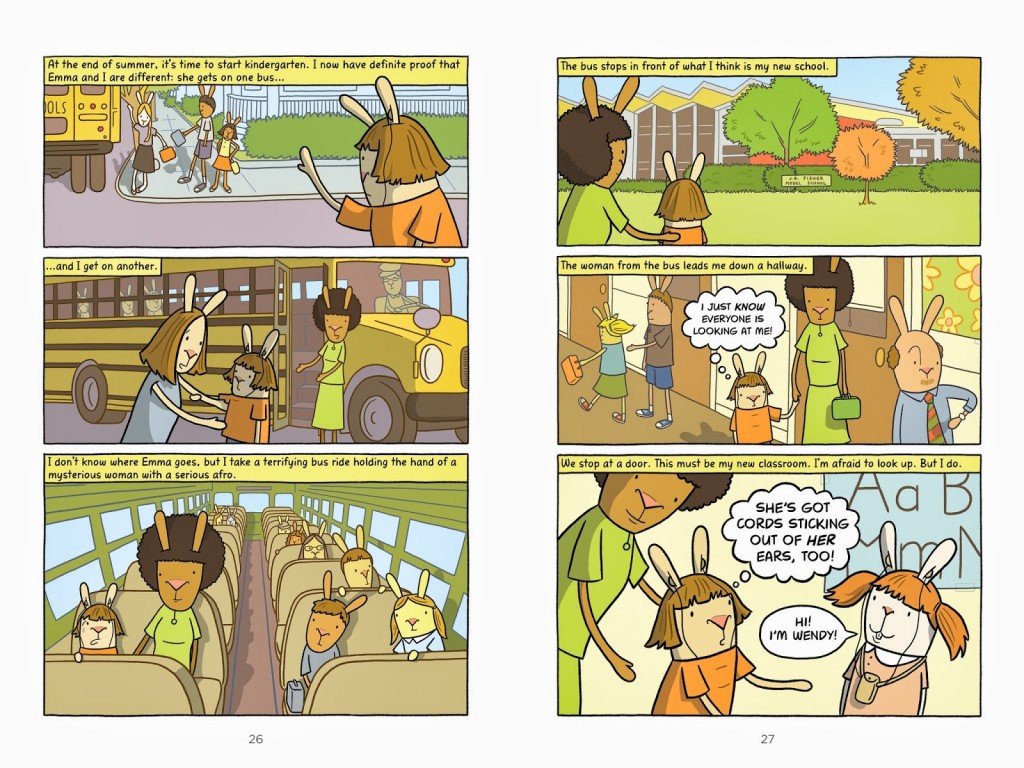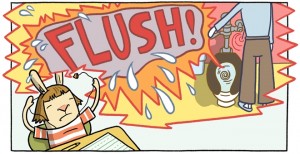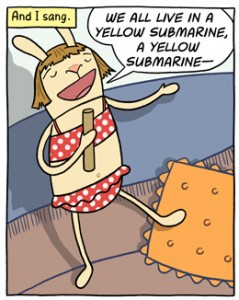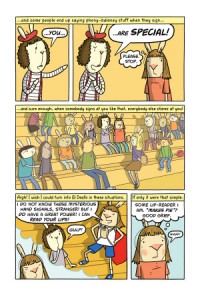Welcome to Using Graphic Novels in Education, an ongoing feature from CBLDF that is designed to allay confusion around the content of graphic novels and to help parents and teachers raise readers. In this column, we examine graphic novels, including those that have been targeted by censors, and provide teaching and discussion suggestions for the use of such books in classrooms.
“And being different? That turned out to be the best part of all. I found that with a little creativity, and a lot of education, any difference can be turned into something amazing. Our differences are our superpowers” — Cece Bell, El Deafo
In honor of the Newbery Award Ceremony taking place later this month, this post takes a closer look at the 2015 Newbery Honor Book, El Deafo by Cece Bell.
El Deafo, a 2015 Newbery Honor Book has also received starred reviews from Kirkus Reviews and Publishers Weekly. El Deafo’s Newbery Honor “for outstanding contribution to children’s literature” is the first given to a graphic novel. In this graphic memoir, Cece Bell discusses with humor and honesty the challenges she faced as young girl after losing her hearing to illness. No one likes being different, and having to wear a bulky hearing aid strapped to her chest certainly didn’t help. Reading El Deafo, we experience what it is like living with severe to profound hearing loss, we see how lonely it can be when communication is difficult, and at the same time we realize that all of us are similar in some ways and different in others. The key is finding the inner strength to embrace our weaknesses and differences, and becoming stronger because of them.
Table of Contents
- OVERVIEW
- SUMMARY
- TEACHING/DISCUSSION SUGGESTIONS
- COMMON CORE STATE STANDARDS (CCSS)
- ADDITIONAL RESOURCES
OVERVIEW
In her heart-warming graphic memoir El Deafo, Cece Bell describes with grace and humor how difficult it was growing up with hearing loss. We learn to understand the communication hurdles Cece faced, and we learn how to more effectively interact with the deaf and hearing impaired. We also more clearly understand how Cece’s hearing impairment set her apart from her classmates and friends and how alone she felt. While she could hear with her hearing aid, it was often difficult to decipher similar sounding words, and this often led to somewhat garbled communication (hearing “I thig yoo loo goo,” “shoes” instead of “juice,” “goat” instead of “coke” are just a few examples).
To help her in school (given the more limited technology of the 1970s compared to what we have today), Cece was given a giant Phonic Ear that had to be strapped to her chest. The bad news: she looked different and even worse, she felt different. The good news: she discovered that the Phonic Ear not only allowed her to hear her teacher, it became her alter ego and actually gave her super powers. When her teacher wore the microphone for the Phonic Ear, Cece could hear her wherever she was in the building. As time passes, Cece realizes she can use El Deafo’s power not only for herself, but for others as well. She becomes the “ears” for the whole class and finds that being different doesn’t mean one has to be lonely or set apart from others.
El Deafo follows Bell as she navigates difficult friendships and the often-problematic communication efforts of her (usually) well-meaning friends. We understand and sympathize with Cece’s embarrassment at being different, and cheer once she discovers the unique ‘super’ powers her Phonic Ear gives her.
The graphic novel format Bell uses for telling this story is a brilliant choice. The fact that the characters are rabbits (providing a wonderful visual metaphor) emphasizes the power of ears and the acute hearing of all those around her. It also allows us to clearly see the hearing aids, their connecting wires, and the bulky Phonic Ear. Another advantage of the rabbit’s ears is that they capture how conspicuous Cece must have felt.
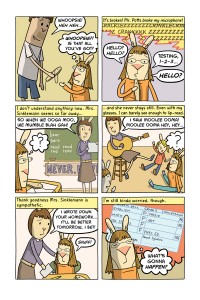
The graphic novel medium also becomes a powerful tool allowing Bell to illustrate how she heard others, and the difficulties she faced comprehending conversations, movies and television. Bell’s use of fading fonts in the text bubbles, empty text bubbles, garbled texts that are difficult to comprehend, and larger than life fonts when people are inadvertently (yet well-meaningly) screaming at her, all help readers vividly and more intuitively understand what hearing loss ‘feels’ like. Finally, Bell’s use of fading and/or vivid colors and play with panel structure and design further help relay Cece’s feelings, thoughts, and reactions as her story unfolds.
From beginning to end, El Deafo is a story about friendship and fitting in. It shows us how to embrace life’s twists and be more sensitive to others. While El Deafo is geared for middle school readers, it is a story for kids and adults of all ages. Readers will learn what it’s like to have severe to profound hearing loss; they’ll learn to better understand how it feels to live with hearing loss; and learn how to more effectively communicate with the deaf and hearing impaired. Finally, it shows that while Ms. Bell’s hearing loss clearly makes her ‘different’ from others, we learn that she is also just like most of us who struggle with a seemingly universal need (especially in middle school) to fit in. El Deafo is an empowering story that shows us how we may all embrace our own weaknesses and insecurities of feeling different, and how these weaknesses and insecurities might eventually make us stronger.
SUMMARY
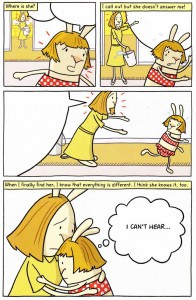
Bell’s graphic memoir El Deafo begins when Cece at age 4 contracts meningitis, and we gradually learn, with Cece that something’s just not right. Through Bell’s brilliant use of text bubbles and fading fonts, we learn that while she survived the illness, she lost most of her hearing. Understandably, Cece becomes scared and confused, and stays “close to Mama, no matter where she is.”
Once diagnosed by an audiologist, Cece is fitted with a hearing aid that, unlike those of today, contains wired earpieces that attach to a box she must wear around her neck. Cece doesn’t like the look or bulk of the hearing aid and decides to hide it under her clothing. Furthermore, she still has some trouble deciphering speech. For example, Cece’s friend asks her if she wants “shoes” (juice) or a “goat.” Looking at the Coke bottle, she says, “I’ll have the goat!” It is then that Cece realizes she’s different from her friend, Emma.
When Cece starts kindergarten at the summer’s end, she finds herself at the J. B. Fisher Model School, a school where ”everyone here is just like me.” Cece and her classmates learn math, reading and writing, “the basics” along with lip reading. As Ms. Bell depicts the lessons she learned from Dorn, her teacher, we too learn the about the intricacies of lip reading. We learn that to lip read effectively one must integrate visual cues (what one sees while a person talks to you), with contextual cues (what’s going on around you during the conversation), and gestural cues (what a person does with their hands, body, and face while talking). We also see that learning to lip read takes A LOT of practice. With Cece’s help, we learn seven additional discoveries about lip reading:
- “A lip reader must see the speaking person’s face at all times”;
- “Exaggerated mouth movements are confusing”;
- “Shouting is not good”;
- Mustaches and beards “are bad news!”
- Hands in front of mouths are “also bad news!”
- “When it gets dark, give up!”
- “Group discussions are impossible to understand.”
As Cece finishes kindergarten, her family moves later that summer and Cece must begin first grade in a new (and bigger) city. While moving to a new place is hard on just about anyone, for Cece, it’s even more challenging, and ultimately very lonely. At summer’s end, Cece begins first grade in a mainstream school. To help her follow her lessons, she’s given a very powerful (and bulkier) hearing aid called “The Phonic Ear.” With it, she can hear very well, but it’s the mid-1970s and the device is large and clunky. We see that Cece’s Phonic Ear is a big box she wears strapped to her chest that has wires running from it up to her ears. To try to look and feel more ‘normal’ Cece wears the receiver under her clothes, and gives her teacher, Mrs. Lufton, a microphone and transmitter to wear as well.
To show us just how large and clunky the Phonic Ear was, and to help us understand how it made her feel so uncomfortably different, Ms. Bell devotes a full-page illustration describing the component elements of the devise. This is done with humor and sensitivity, and readers can readily infer how The Phonic Ear felt and sounded, and how uncomfortably different Cece must have felt. We learn, for example that, “Underside of Phonic Ear: Freeeezing cold in winter, hot and sweaty in summer; therefore, undershirt a must!” Toward the bottom of this self-portrait, an arrow points to: “Underpants! avert your eyes!”
While The Phonic Ear is cumbersome at best, Cece immediately recognizes that it helps her hear Mrs. Lufton. In fact, it’s so strong she can hear her teacher when she isn’t even in the same room. Cece can hear her in the hallway, she can hear her talking to other teachers in the teacher’s lounge, and she can even hear her in the bathroom.
It hits Cece that, “I have amazing abilities unknown to anyone! Just like Bruce Wayne uses all that crazy technology to turn himself into Batman on TV…I can use my own crazy technology… to turn myself into a superhero, too!” On the other hand, Cece also realizes that “Superheroes might be awesome, but they are also different. And being different feels a lot like being alone… Wherever I am… it feels like I’m always inside my bubble…”
It is then that she begins to think of herself as a superhero, El Deafo. El Deafo initially serves as her alter ego, giving voice to her inner thoughts and feelings while helping her navigate difficult or uncomfortable situations. When first discovering these powers, Cece keeps them a secret. But in fifth grade, she gains new popularity with her classmates when she uses her Phonic Ear for the good of others as well. When the teacher leaves the room for “Quiet Math” (which they all dislike), Cece keeps ‘watch’. As soon as her teacher Mrs. Sinklemann leaves, the kids play. As Cece hears Mrs. Sinklemann returning down the hall (with the awesome powers of her Phonic Ear), she warns them that their teacher is approaching. Thanks to Cece they can quit goofing around before she enters the room. “For the first time ever,” Cece announces, “El Deafo uses her superpowers for the good of others.”
Cece’s life is full of the drama and trials. And, while most of her friends are good intentioned, many make mistakes, many don’t fully understand her, and inevitably, Cece still feels lonely. One friend pushes her to do only what she wants, never accepting Cece’s suggestions and alternatives. Another friend, shouts at Cece and slows her speech, thinking it will make it easier for Cece to hear, when it only makes it more challenging. Others, invite her to sleepover parties and once the lights are out, or they are all talking quickly in a group and not necessarily looking at her, making it difficult for Cece to follow their conversations. Then too, Cece feels alone. Once Cece shows her friends her Phonic Ear, and uses it for the good of others, she is more accepted by others (even her friend Ginny talks to her “in a normal way”), she becomes the class hero, and she realizes that being and feeling different doesn’t mean one has to be alone.
In short El Deafo is a warm uplifting story of how a young girl bravely and honestly deals with being different. It is a book about growing up, learning how to fit in, and a book about friendships. Equally empowering, it is a book about what it looks and sounds like when living with severe hearing loss, while teaching us how to better understand and communicate with the deaf and hearing impaired.
Throughout El Deafo, Ms. Bell discusses:
- How to cope with life’s misfortunes;
- How one brave girl finds inner strength;
- How to find one’s voice, especially to express needs and concerns;
- How to distinguish true friends from ‘comfortable’ friends and even non-friends; and
- How to better recognize the challenges faced by people with hearing loss, and more effectively communicate with them.
TEACHING/DISCUSSION SUGGESTIONS
Plot, Themes, and Values Related
- Discuss and chart the different themes Ms. Bell presents in this work.
- Discuss ways one can be “different” from others and the importance of “fitting in.” Brainstorm and evaluate all the different ways people can feel and look different. Then discuss what you might do to help them more effectively fit in.
- Discuss different types of friendships one might have with others. Detail what it means to be a good friend. Does this definition of “friend” change if/when one someone health issues? If so, how? Discuss the challenges we have in determining and maintaining friendships and why this is so important.
- Research and discuss what meningitis is.
- Research/discuss/define different forms of hearing loss.
- Research and discuss how technologies are used today to help all kids of people with hearing, visual, and motor loss.
Critical Reading and Making Inferences
- Discuss in what ways Cece’s childhood is like yours? How is it different?
- Discuss and evaluate why Cece is embarrassed about her hearing loss? What other things might people be embarrassed about? What might they be able to do about it?
- Evaluate and discuss the ways El Deafo helps Cece.
- Why is it sometimes easier for Cece to be alone than deal and interact with the kids in her neighborhood?
- Create a working definition of “hero.” Discuss and analyze how Cece and her alter ego El Deafo do or do not fit the class definition.
- On page 23, Ms. Bell writes, “Emma and I have always looked different from each other, but in ways that didn’t matter.” Discuss the ways looking different doesn’t matter. Discuss the ways looking different does matter. Discuss why that is.
- Evaluate and discuss what Cece means on page 51 when she says that, “Being best friends with Laura isn’t perfect but it sure beats being in a bubble.”
- On page 57 El Deafo ‘tells’ Cece that “It’s time to push back” and not let Laura run everything. Do you agree, was it time for Cece to push back? Why or why not? How does one determine the “right” time?
- On pp. 96-98 why doesn’t Cece tell the kids what’s bothering her about the sleepover? Why does she just decide to leave, instead? Discuss situations when students might be uncomfortable relating their feelings and why.
Language, Literature, and Language Usage
- Discuss why some people don’t like the terms “handicapped” and “disabled.” Brainstorm what other words might be more socially acceptable?
- Have students go on a scavenger hunt for idioms, slang, colloquialisms, metaphors, and similes throughout El Deafo. For example:
- On page 33, she discusses feeling lost “ drifting along on our own planets”
- On page 47, Ms. Bell relates, “Wherever I am… it feels like I’m inside my bubble.”
- Compare and contrast the language Bell uses to tell her story versus the language she uses to tell El Deafo’s.
- Have students create and share their own stories of feeling different and/or their stories of trying to fit in. Compare and contrast how the stories are told/ written, and chart the words used to relate their challenges and their feelings.
- Discuss why Ginny thinks that Laura is “like the Snow Queen in Narnia” (page 65).
Modes of Storytelling and Visual Literacy
In graphic novels, images are used to relay messages with and without accompanying text, adding additional dimension to the story. In El Deafo, Ms. Bell deftly weaves story and background with image, text, and design. Reading El Deafo together with your students allows you to analyze, discuss and learn how Ms. Bell uses page and panels, text and images to deftly express and explain what if literally feels like to be deaf. For example:
- Search and discuss Ms. Bell’s use of visual metaphor throughout the book. For example:
- Discuss her use of depicting her characters as rabbits;
- On page 24, she uses a visual metaphor describing that to her, when people speak it sounds like she’s underwater.
- Evaluate and discuss how Bell so effectively relates what it’s like to have severe hearing loss through the use of text and image. Evaluate and discuss how Bell relays the difference between what people say and what she might hear.
- Compare and contrast when Bell uses a full-page single-panel splash versus pages with multiple panels. Chart when she uses single-panel splashes (to emphasize key events or separate chapters and slow the reader down to emphasize particular points of the story) and discuss how effective this method is when story-telling with images. For example:
- Page 39: Why might Ms. Bell have decided to devote a full page to discuss what it was like wearing The Phonic Ear?
- Pages 46-49: Evaluate and discuss how Ms. Bell uses the images on this page to relay how lonely she felt.
- Discuss Ms. Bell’s use of panel shapes to distinguish between real life events and the escapades of El Deafo. What other ways are the panel shapes and borders used to help tell the story?
- Discuss how Ms. Bell shows us how lip read (pp. 29-33 and pp. 74-75).
- Chart the different expressions and body language/postures you can distinguish and what each image relays. Discuss why being able to “read” facial expressions and body language is so important to communication. You may even want students to do their own ‘research’ with a camera, trying to ‘capture’ different expressions and postures of their family members or friends in action.
Content-Area Lessons
- Science/History: Have students research and discuss meningitis causes and treatment. Have them research, compare, and discuss how it was treated in the 1970’s when Cece was a girl and how it is treated today. Discuss what, if anything has changed.
- Science/History: Have students research and discuss different types of hearing loss and how it is treated today. How is its treatment today different from the treatment in the 1970’s? How is it different from the 1870’s? How might it be different in the future?
- Math/Science: On page 17 Ms. Bell shows us different charts that relay her hearing loss. Use this image to discuss how different charts can be used to relay different types of information. Have students create their own charts to relay various types of information.
Suggested Prose Novel and Poetry Pairings
For greater discussion on literary style and/or content here are some prose novels about growing up, about being a pre-teen/teen, and about challenges of middle school and high school that you may want to read and pair with El Deafo:
- Smile by Raina Telgemeier –a graphic memoir about the pains and traumas of being different as the result of an accident requiring years of dental work.
- Freckle Juice, Tales of a Fourth Grade Nothing, Are You There God? It’s Me, Margaret, and Otherwise Known as Sheila the Great – just a few of the books Judy Blume wrote about the honest and humorous trails of growing up.
- The Chronicles of Narnia by C.S. Lewis – considered a classic of children’s literature, this series takes place in a fantasy world as it narrates the adventures of four children who play central roles in Narnia’s unfolding history. It is referenced in El Deafo.
- The Diary of Anne Frank by Anne Frank – relating what it was like as a Jewish girl hiding from the Nazis.
- Johnny Tremain by Esther Forbes about life for a teen living in Boston at the start of the American Revolution, and how he adjusts to life after a terrible life-changing accident.
- Wonder by R.J. Palacia is about Auugie, a boy born with a terrible facial abnormality who realizes, “You can’t blend in when you were born to stand out.”
- Hidden by Loic Dauvillier – a poetic graphic novel where Dounia, a grandmother, tells her granddaughter the story (even her son has never heard) of how, as a young Jewish girl in Paris, she was hidden away from the Nazis by a series of neighbors and friends who risked their lives to keep her alive when her parents had been taken to concentration camps.
COMMON CORE STATE STANDARDS (CCSS)
While this book is intended for middle school readers, it is appropriate for students in grades 4 and up. As it covers so many ages and grades, I will be using the Common Core Anchor Standards for College and Career Readiness for Reading, Writing, and Speaking and Listening. Please note that in addition to meeting the CCSS (as detailed below) El Deafo is a story of tolerance and coping that promotes critical thinking; that clearly relays how to more effectively communicate with the hearing impaired; and provides insights into how science and technology can help individuals with hearing loss.
- Key ideas and details: Reading closely to determine what the texts says explicitly and making logical inferences from it; citing specific textual evidence when writing or speaking to support conclusions drawn from the text; determining central ideas or themes and analyzing their development; summarizing the key supporting details and ideas; analyzing how and why individuals, events, or ideas develop and interact over the course of the text.
- Craft and structure: Interpreting words and phrases as they are used in a text, including determining technical, connotative, and figurative meanings and analyzing how specific word choices shape meaning or tone; analyzing the structure of texts, including how specific sentences, paragraphs and larger portions of the text relate to each other and the whole; Assessing how point of view or purpose shapes the content and style of a text.
- Integration of knowledge and ideas: Integrating and evaluating content presented in diverse media and formats, including visually and quantitatively, as well as in words; delineating and evaluating the argument and specific claims in a text, including the validity of the reasoning as well as the relevance and sufficiency of the evidence; analyzing how tow or more texts address similar themes or topics in order to build knowledge or to compare the approaches the author takes.
- Range of reading and level of text complexity: Reading and comprehending complex literary and informational texts independently and proficiently
ADDITIONAL RESOURCES
- https://www.youtube.com/watch?v=Cnj5STG0SZo — Cece Bell talks about El Deafo
- http://www.npr.org/player/v2/mediaPlayer.html?action=1&t=1&islist=false&id=369599042&m=370792979 — “El Deafo: How a Girl Turned Her Disability Into a Superpower,” NPR interview from December 15, 2014, on All Things Considered
- http://marycrockett.com/2015/03/05/cecebell/ — “The Story Behind El Deafo – A Virtual Exhibit of Cece Bell’s Newberry Award Winning Graphic Novel,” webpost by Mary Crocket Hill, March 5, 2015
- https://www.youtube.com/watch?v=8HRi3DNy6ic — YouTube Cece Bell created after hearing El Deafo was named a 2015 Newbery Honoree, including actual email sent to her by Randall Enos, Chair of the ALSC John Newbery Award Selection Committee
- Visit Cece Bell’s website: https://cecebell.wordpress.com/2015/03/11/the-shadow-knows/ – more-2135
- http://www.nytimes.com/2014/08/24/books/review/el-deafo-by-cece-bell.html?_r=0 — “Sonic Youth: El Deafo by Cece Bell,” from The Sunday New York Times Book Review, written by Katherine Bouton, August 22, 2014
- http://www.washingtonpost.com/blogs/answer-sheet/wp/2015/02/10/why-everyone-should-read-this-graphic-memoir/ — “Why Everyone Should Read This Graphic Memoir,” from The Washington Post, by Valerie Strauss, February 10, 2015
- https://cecebell.wordpress.com/2014/09/16/el-deafo-extras-mrs-lufton-revealed-well-kinda-plus-mini-book-tour-only-a-week-away-dc-area-peeps-id-love-to-see-you/ — “El Deafo Extras: Mrs. Lufton Revealed,” post from Ms. Bell’s El Deafo webpage
- http://kidshealth.org/kid/health_problems/sight/hearing_impairment.html — “Kids Health: What’s Hearing Loss?,” describes hearing loss and hearing impairment, types of hearing loss, how hearing works, what causes hearing loss, how audiologists test for hearing loss, how hearing loss is treated, and much more.
- http://kidshealth.org/kid/health_problems/brain/meningitis.html and http://kidshealth.org/parent/infections/lung/meningitis.html — “Kids Health: Meningitis,” describes meningitis, how someone might contract meningitis, how it spreads, possible complications, symptoms of meningitis, how meningitis might be treated, and more.
Meryl Jaffe, PhD teaches visual literacy and critical reading at Johns Hopkins University Center for Talented Youth OnLine Division and is the author of Raising a Reader! and Using Content-Area Graphic Texts for Learning. She used to encourage the “classics” to the exclusion comics, but with her kids’ intervention, Meryl has become an avid graphic novel fan. She now incorporates them in her work, believing that the educational process must reflect the imagination and intellectual flexibility it hopes to nurture. In this monthly feature, Meryl and CBLDF hope to empower educators and encourage an ongoing dialogue promoting kids’ right to read while utilizing the rich educational opportunities graphic novels have to offer. Please continue the dialogue with your own comments, teaching, reading, or discussion ideas at meryl.jaffe@cbldf.org and please visit Dr. Jaffe at http://www.departingthe text.blogspot.com.
Help support CBLDF’s important First Amendment work by visiting the Rewards Zone, making a donation, or becoming a member of CBLDF!
All artwork (c) Cece Bell.


